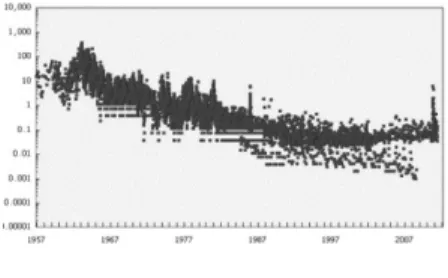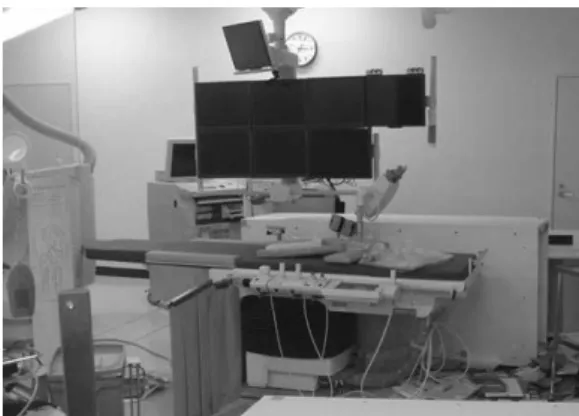「仮設住宅における在宅医療を、中核病院にシームレスにつなぐIT電子診療システム」(日本語版)
8
0
0
全文
(2) 地震予測はことごとく外れていることが問題視されているが、その中でも宮城 県沖では99%の確率での巨大地震発生が予測されており、早くから対策は進 んでいた地域に入るものと考えられていたが、2011年3月11日に、東日 本震災発生し、歴史観測史上最大を超えるマグニチュード9.0、特に大崎平 野などでは震度七の最大深度を記録、激震でインフラがことごとく破壊され、 沿岸部は津波と火災で壊滅、福島原発のメルトダウンで、首都圏がパニックと なり、東北以南からの物流が途絶した。通信網の寸断で情勢が把握しきれず、 道路網の寸断で物流が途絶し、病医院では診療に多大な阻害をきたした。津波、 地震、火災、原発事故で被災した市民は急増された避難所に難を逃れたが、物 資が途絶して、一時は避難者の飢死の可能性まで指摘された。 これに関しては、原発被害による風評被害で関東以南からの物資輸送が途絶し た原因も大きく、現在は、この風評被害によるメディカルサプライの途絶は、 国際的な医学文献の上でも問題とされている(Artif Organs 30; 760-763, 2012) 東日本大震災は甚大な被害をもたらしたが、その中でも最大の激震地域である 震度七を記録した大崎平野において救急医療の中核を担う宮城県立循環器呼吸 器病センターでは、一時、電源、ガス、水道ともライフラインが途絶し、病院 機能の維持に難渋したが、自家発電が稼働、入院中の患者を維持し、外来患者 は一時帰宅を願いし、津波被災地などからの救急搬送も受け入れると同時に、 東日本全体の被災地からの避難民を栗原地震で建設していた避難所へ受け入れ、 被災者の健康維持に尽力した。 ところが津波の被災地などではご開業の先生方が建物ごと壊滅しており、現実 には医療インフラが壊滅していて、栗原市でも永遠に被災者の医療システムを 維持しなくてはならない事態に陥っている。そこで医療インフラ再生、都市機 能再生のために注目されたのが、東北大学で開発がすすめられていたメディカ ルITによる地域医療ネットワークの再構築構想である。 震災に被災した地方都市では、もともとご開業の先生方が高齢化していたこ ともあり、この震災を機に医院を閉鎖し、リタイヤされる先生方も数多い。さ らに厚生労働省の指導で中核病院は在院日数を減らしているので、在宅へ戻っ た患者さんは、ご開業の先生方がいないと、現実に行き先がなくなるのが、東 日本震災の復興現場の現状である。 そこでメディカルITによる電子診療鞄などを駆使して、在宅の患者さんたち と、地域中核病院、大学病院を直接つなぎ、クラウドに挙げた医療情報を共有 することで、地域医療の再構築、地域都市計画の再構築を計り、地方における 地域都市計画のモデルとなるような展開を試みる研究を行う。 地方都市における医療崩壊は、今回の震災に限らず、既に日本の地方都市に おけるデファクトスタンダードになっており、地方における都市再生には、医.
(3) 療システムの機能再生が不可欠である。日本が得意とするITをメディカル分野 に拡張し、栗原市における中核病院と、避難所、仮設住宅との医療連携を具現 化すれば、地方社会における医療再生のモデルケースとなり得る。 In March 11, 2011, the largest Disaster had attacked the East side of Japan. This big disaster was called the East Japan earthquake or Sendai quake (Wikipedia). Magnitude 9.0 earthquake had been continued too long time, because three epicenters had been combined at Sendai quake. By this reason, large Tsunami (Big wave) had attacked the cities in the east side sea shore in Tohoku Area (North east side of Japan). Furthermore, the fire attacked the cities after earthquake with the Tsunami attack, large part of cities near sea shore had been lost. In addition to these disasters, Fukushima nuclear power plant had showed the Melt down. Radiation materials had been scattered, not only to Japan, but also to all over the world, unfortunately. Sendai quake had been the largest disaster in the history of all over the world, because it had been the combined disaster including Earthquake, Tsunami, Fire, and Nuclear power plant meltdown. This complex disaster had been the first experience of the human being. A lot of people had to go away from their home town by this disaster. And they had to go into the shelter. Anti nuclear activists has spread the irresponsible rumor. They had spread the unscientific terrible rumor, delivery support could not go into the disaster area. The people in the shelter could not receive the foods and drugs by left wing anti nuclear activists blockade. Strategy, tactics and logistic are the three important factors, when we consider the War. In Sendai quake, logistics of medical engineering had been the especially important issue. One of the more important problem at the time of disaster had been the medical resource logistics. Anti nuclear power activists had spread unscientific rumor concerning the risk of radiation fall. By this rumor, medical resource delivery from west side Japan had blocked at the border of Fukushima prefecture. Fukushima was located in the south border of East japan area. If the delivery from west area was blocked at the fukushima border, all thing could not deliver to the all over disaster area. Most important issue was logistics From Tohoku University Hospital's director, message of the request for all medical equipment and DMAT support had been send to all University hospital in all over Japan. Huge number of medical resource and large number of DMAT had gathered to Sendai.
(4) city and delivered to the all disaster area. Some resources were too much, and some materials were too small. Most important thing was the logistics. Fig.1 Strontium falls in Japan In 50's to 60's, there were large amount of radiation material falls in Japan by the reason of atomic bomb's experiments in all over the world. Fig.1 showed the data of strontium falls in atmosphere of Japan. Thousands times of strontium fall was observed in 60's,even compared after Fukushima accident. But, anti nuclear power activists has been continue to spread unscientific terrible rumor until now., though the radiation scatter had been terminated. Delivery to the disaster area are still disturbed by anti nuclear activists. In sense, a lot of people had been killed by the shortage of drugs.. On March 11, 2011, disaster struck the east coast of Japan (1–7) in the name of the Great East Japan Earthquake or Sendai Quake (8). (Wikipedia) Japan had been expecting a large earthquake for a long time. The Sendai Quake involved three epicenters at various distances out to sea. The force of the magnitude 9.0 quake caused an enormous tsunami that deluged the cities on the eastern seashore in the Tohoku area (northeast coast of Japan). In Minamisanriku City, for example, almost all buildings were lost after the earthquake and tsunami struck. Fig. 2 Minamisanriku City after the tsunami (photo by the Miyagi Medical Support team).
(5) To add the disaster, fires broke out after the earthquake and tsunami. Large portions of the cities near the eastern seashore were completely lost. In addition to these disasters, a meltdown occurred at the Fukushima nuclear power plant. Radioactive contamination occurred not only throughout Japan but also all over the world. Unfortunately, detailed medical data about the aftermath of the Sendai Quake is not available because all medical records were lost with the hospital buildings, especially in the tsunami areas near the eastern seashore. Detailed information of the number of dead has not yet been summarized, even by the Japanese government. As many as 20,000 people have been reported lost as a result of this complex emergency. The medical response following the earthquake and tsunami in eastern Japan has not been clearly described. This short report is intended to provide details of this response. Tohoku University Hospital is located in Sendai City in the area that sustained the most damage from the tsunami and earthquake. Despite the sadness that flooded the nation after the disaster, one consolation was that no fatalities occurred among patients, doctors, nurses, or other staff at the University Hospital. The response to the disaster at this hospital can be examined in four stages. The first stage involved initial recovery and preparation for dealing with the aftereffects of the disaster. First, the safety of all patients and staff members was secured. Then, medical resources were mobilized according to the hospital’s triage tag system. Everything in the University Hospital was rearranged to accommodate disaster victims. All routine surgeries and medical examinations were postponed, and the outpatient clinic was closed. When disaster victims arrived at the University Hospital, they received green, yellow, red, or black tags, according to the methodology of the triage tag system. Patients with green tags were treated in the outpatient clinic, those with yellow tags went to the intensive care unit, those with red tags went to the operating room, and those with black tags went to the building of basic science. Appropriate treatment was delivered in these various locations. In the second stage, normal hospital functions were restored. Planning began for the acceptance of patients being transferred from damaged hospitals on the eastern coast. Shortages of all medical resources had been anticipated, so messages were sent to all university hospitals in Japan to gather drugs and food and to prepare disaster medical assistance teams. In the third stage, teams of doctors and nurses, along with medical resources, food, and drugs, were sent to the afflicted hospitals. Thousands of medical support teams were sent to the cities on the eastern coast affected by the tsunami. The fourth stage, which.
(6) involves reconstruction of medical support buildings in the damaged area, is still ongoing. Challenges were multiple throughout the region. Creative solutions to various problems had to be sought. For example, in THE Miyagi Cardiovascular Respiratory Center, electric power and water supplies were down. Patients in stable condition were therefore discharged, and emergency patients were treated using equipment powered by in-house power generation units.. Fig. 3 Cardiac catheterization room after the Sendai Quake Despite all the efforts to meet people’s needs, medical resources were inadequate because of the magnitude of the disaster. Medical equipment was damaged and debris was everywhere. Medical teams visited shelters after the tsunami (Fig. 1). The Miyagi Medical Support team diagnosed and treated in a temporary shelter. An emergency care unit is present in Sendai City Hospital. Although ambulances had been salvaged from the disaster area, destroyed roads and traffic jams prevented them from being transported to the hospital. Many patients came to Tohoku Rosai Hospital, located in the city center, on foot. The volume of patients was large, and the hospital so busy that medical staff were unable to return to their homes. Miyagi Shakaihoken Hospital is located near the coast. Many tsunami victims went to that hospital, but the surgery department’s systems were down. Patients could not be adequately treated without functional operating rooms. The most severe damage was observed in Kesennuma City near the seashore. All buildings in that area were destroyed by the earthquake, tsunami, and fire; therefore, people were required to go to refuge centers. Control of hypertension, diabetes, and many other health disorders was difficult in these makeshift conditions, and newly developed electronic doctor’s bags were used to control these conditions..
(7) Furthermore, the Sendai Airport was also completely destroyed by the Tsunami Attack, but it was restored soon by the TOMODACHI operation carried out by the United States Army. The Fukushima nuclear power plant accident exacerbated the already difficult situation in hospitals. On March 11, a meltdown at the power plant was reported, and hydrogen explosions followed on March 12 and 14. Radioactive materials were scattered as a result of these accidents. The plant was shut down. In Japan, discussion is ongoing concerning the future consequences of the radiation leaks resulting from the accident at Fukushima (9–12). In the early 1960s, Japan experienced a large amount of strontium, cesium, and plutonium fallout caused by atomic bomb experiments conducted by several countries, including the United States, France, the Soviet Union, and China. Plutonium levels in Japan were estimated to be 100,000 times higher in the 1960s compared with recent levels. But, life span of Japanese people is longest in advanced countries. No one can show the risk of radiation fallout in early 60's No increase in cancer incidence was observed in Japan in the early 1960s. Thus, the true risk of radiation fallout is also unclear, because double-blind tests of radiation poisoning cannot be performed. Sendai City is located north of Fukushima. All roads from Tokyo (south of Fukushima) and other areas of Japan had been blocked between the Fukushima and Tokyo, because the anti nuclear power activists announced the non scientific propaganda concerning the risk of radiation material fall out. Relief supplies could not enter into the Fukushima area by anti scientific dema from the anti nuclear activists. So, the Relief goods could not go into Sendai. Many patients did not survive because of a shortage of drugs and food by the propaganda of the anti nuclear activists. At the time of disaster, more than 50 patients were on respirators, whereas 11 were dependent on hemodialysis (HD) in Tohoku University Hospital. Emergency power units ensured the safety of these patients. However, all coastal hospitals had sustained devastating damage. Therefore, all patients who were dependent on HD were transported to Tohoku University Hospital. Medical resources were inadequate to meet their needs, and helicopters transferred these HD patients to other hospitals. Around one hundred HD patients had been transferred to the another hospitals. Especially, large number of HD patients was transferred to Hokkaido..
(8) Three patients required the Nipro ventricular assistance system (VAS) support in Tohoku University Hospital during the Sendai Quake. Because emergency power had started smoothly, no disruption of VAS treatment occurred. However, certain lifelines, such as electric power, water, and gas supplies had all been shut down in Sendai City. Therefore, patients requiring rotary blood pumps were transported to the ambulance center and subsequently moved to the University Hospital after the roads became passable. Pneumatic VAS remained useful during the disaster, which was surprising because they were situated in the hospital with the emergency power unit. We are now starting the survey of health care in Disaster area. REFERENCES [1] http://search.kankyo-hoshano.go.jp/fg_EstablishKind.jsp [2] T.Yambe, et al; “Medical response to Sendai quake., Artificial Organs 2012..
(9)
図


関連したドキュメント
災害に対する自宅での備えでは、4割弱の方が特に備えをしていないと回答していま
② 特別な接種体制を確保した場合(通常診療とは別に、接種のための
後援を賜りました内閣府・総務省・外務省・文部科学省・厚生労働省・国土交通省、そし
②防災協定の締結促進 ■課題
在宅の病児や 自宅など病院・療育施設以 通年 病児や障 在宅の病児や 障害児に遊び 外で療養している病児や障 (月2回程度) 害児の自
東京都環境局では、平成 23 年 3 月の東日本大震災を契機とし、その後平成 24 年 4 月に出された都 の新たな被害想定を踏まえ、
防災 “災害を未然に防⽌し、災害が発⽣した場合における 被害の拡⼤を防ぎ、及び災害の復旧を図ることをい う”
ここで,図 8 において震度 5 強・5 弱について見 ると,ともに被害が生じていないことがわかる.4 章のライフライン被害の項を見ると震度 5